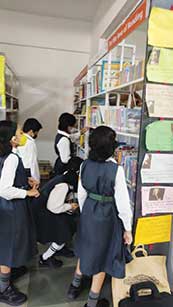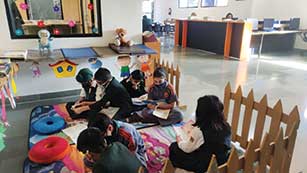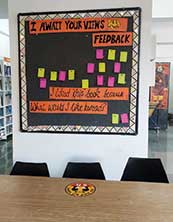Geetanjali Mehra
One of the major experiences of my life which gave me the opportunity to evolve in many ways was the Library Educators Course at Bookworm in Goa. Library Educator is a word that brings together the responsibilities and knowledge of both, a librarian and an educator. Hence the person involved is intellectually and emotionally there for every child to make him/her/they feel safe and special in the world of books.

During the journey of LEC, I walked through stories and books like never before, feeling that sense of a presence in my mentor and other faculty, as well as in participants. LEC ensured doing a field project which was a real life experience in the library with the children. The objectives of my field project included exploring what it meant to create an ambience in a school library that fosters more engagements for children.
Libraries are the places where people and books come together but one should be seen as reflecting upon the other. I wanted to see a critical shift in children from quiet, docile readers to independent and adventurous readers, readers who are eager to enjoy the text on their own terms and make their own choices and also to encourage non-readers.
I worked on my field project in my school library, (Delhi Public School, Pune), hence my reflections throughout the span concentrated on “how”, “what kind of” and “why involve ENGAGEMENTS” to help bring the actual essence of the school library to light for the children and myself.
Rationale
My reasons for attempting this topic in the field project were because of the stirrings of what is possible in a library that the course had evoked in me. I was further supported when I read Emily Ford, who writes,
“Our conversations aren’t working because our language isn’t working because our day to day thinking is not working. We should be engaging in a different conversation with ourselves and our community of library workers. We should individually and collectively reflect on the question: What do we do and why do we do it?” – (Emily Ford, 2012)
During the journey of the field project I underwent certain reflections which helped me evolve every time as an educator.
My pre-planning and reflection here guided me to be “flexible”
I observed during my first contact of LEC that this was not a usual sail with children in school as it is for a class teacher – a well-disciplined class, a perfect lesson plan, a strict teacher, desks and chairs. It was completely different.
I needed to prepare myself for the class/session before I was there with the children in the library as I did for my regular teaching sessions, but in the library, for a librarian, the challenge can be the “non-readers” who may not respond in the most anticipated way and later may create a havoc in the library “as a setting” and “as a reading place”. Hence as a librarian I had to be flexible and have a plan B ready to involve non-readers in a way that leads them to pick up a book and spend quality time with it.

How teaching-learning tools create a difference in library sessions too: Using different storytelling methods and props for sessions depending on the need of the story based on children’s interests and needs, lead to a healthy and engaging discussion on the story that can lead to an understanding.
“Understanding is developed through relationships in which the child engages in discussions and dialogue with others.” (Edwards 1986, Feeney, Christensen, & Moravick 2006)
Children’s own way of selection: Another reflection that struck a chord with me was that children have their own mechanism of selecting books from the shelves but then for that they need to visit the shelves and feel free. Hence, independence to move freely and feel the books was the first pre-requisite for an open library.
Children cannot be contained in boundaries of age groups, and their choice in reading should not be influenced. Although guidance by the librarian does help a child and that is what encourages the importance of “engagements” in a library.
(Unnatural selection: More librarians Are Self-Sensoring, Linda Jacobson).
What I was looking forward to: This led to the reflection on what I am looking forward to in the library in future, children browsing the shelves without a fear of eyes chasing them while they browse the books and children reading and talking about books in deeper ways.
“Browsing information and communication media are the fundamental and pervasive human social activities, central to survival, learning, and understanding, creating, enjoying and interacting.” (Rice, McCreadie and Chang 2001, 312)
Ambience and appearance: One other aspect which I observed and tried to work upon for a long-term vibrant library was the ambience and appearance of the library. A comfortable story time corner was created and I observed that children were enjoying the floor arrangements and freedom to sit as per their will to enjoy the reading time.
Reading in a different ambience, nature walk inside the school ground and garden and children choosing a place for themselves to read amongst nature and under trees also helped them choose their place of reading. They seemed to have enjoyed the idea.
Reading can be encouraged from one child to another: Throughout these sessions I observed the keenness for reading aloud. Reading aloud leads to – independent reading, stretches attention span, stimulates imagination, fosters critical thinking skills. (Jim Trelease’s The New Read Aloud Handbook).
In a read aloud situation, two texts exist. (Fox Mem. Reading Magic 2001: why reading aloud to our children will change their lives forever).

Group activities: Readers’ theatre activities and literature circles which involved more than one/two participants and confident faces stimulated in the children the desire to know the stories and know more books.
“The books that matter in our lives are the books we have discussed.” (Lucy Calkins, 2001)
Bookworm, during LEC, had introduced the participants to the idea and importance of making library cards.
The idea when brought to children, displayed a sense of ownership, responsibility in them towards the books which they borrowed from the library to read.
How engagements create a bond between the librarian and the student: A conventional library is different from a lively library where the children are able to reach out to the librarian. This reflection answered all my queries and the search for soul in the library was over. It was right there and only needed to be explored through the engagements.
These reflections opened the doors for me to understand the children and work with them in the library. A board was put up to receive feedback from children so that the engagement could be welcomed from the children’s side as well and what they expect in an open library. This gave children a way to express their views. Children were given the independence to browse all the shelves, issue books during examination days and the librarian’s engagements with the children opened up opportunities for discussion, learning, listening, and expressing. The library has become a place to be visited and explored for the children.
LEC helped me evolve and understand that children cannot grow in the shadow of life. We should allow them to read the stories they like, ask questions, enjoy the real pleasure of their lives by understanding it better. But if we cannot guide our children to the answers or at least direct them to finding their own answers then “are we educators”? or “are we just information givers”?
LEC helped me – a teacher – to think in a way for the children, for the society as a whole, for my growth from an individual to a facilitator, to a holistic educator in the library.
LEC, I can assure is making and guiding educators so that they are there for the children, for the society at large and standing tall with their vision.
I am a proud teacher librarian.
References
• Comp (2021, unit 4) Appearance, ambience and agreements in a children’s library, Usha Mukunda (2016)
• Fox Mem. Reading Magic 2001: why reading aloud to our children will change their lives forever
• Comp. 2021 (Unit 4) Nurturing Readers by Reading (Sujata Noronha 2016)
• Comp. 2021 Unit 4, A case for Browsing: An empowering Research Strategy for elementary learners, Barbara Montgomery, 2014
• Comp. 2021 Unit 4, Being flexible as Library Educators (Sujata Noranha, 2021)
• Comp. 2021 Unit 1, What do we do and why do we do it? In the library with the Lead Pipe (Emily Ford, 2012)
• Feeney, SD Christensen &E Moravick 2006, Who am I in the lives of children? An introduction to teaching young children
The author is a Lead Teacher (Read Programme) at Delhi Public school, Pune. Her participation in Library Educators Course at Bookworm, Goa helped her evolve as a teacher librarian who designs activities to encourage children to connect themselves with books and reading for pleasure. She can be reached at geetanjali.mehradpspune@gmail.com.
